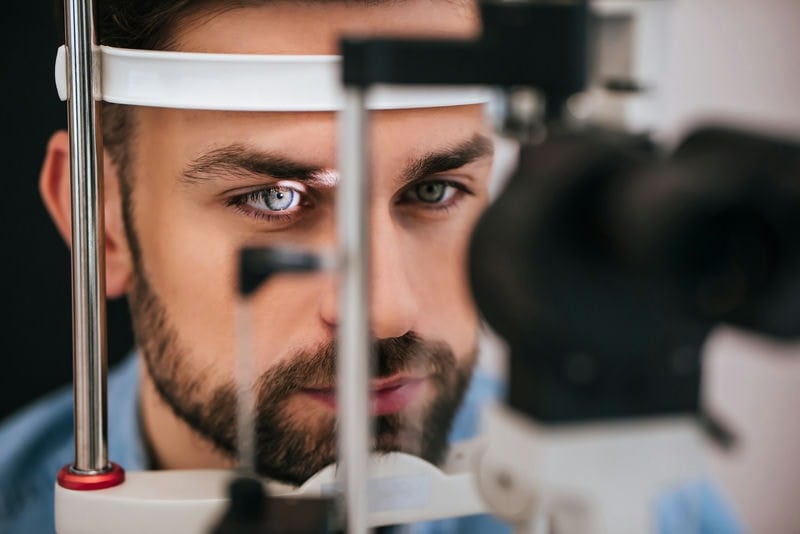
What are punctal plugs?
Punctal plugs are small plugs that are inserted into the lacrimal points to prevent tear drainage. This enables the tear film to be preserved for a longer time on the surface of the eye to relieve the symptoms of ocular dryness and prevent damage that can occur in the cornea.
They are almost invisible to the eye and are usually made of silicone, although, in some cases, temporary plugs made of collagen, a natural substance that dissolves and is absorbed by the body after a few weeks, can also be used.
In which cases are they used?
They are indicated for dry eye patients who have severely reduced tear production. This occurs, above all, in postmenopausal women or elderly people. The most serious cases are associated with Sjögren’s syndrome, an autoimmune disease that affects the external secretion glands (exocrine) of the body, especially the lacrimal and salivary glands.
Prior examination
In addition to performing a complete optometric and ophthalmic assessment, the specialist may require additional tests for the diagnosis of dry eye, such as Schirmer’s test, which measures tear quantity by means of paper strips that are placed on the external lateral part of the eye and determines whether there is a deficiency in production.
During treatment
The procedure is performed in the consulting room under topical anaesthesia (drops) and is completely painless for the patient. The punctal plugs can be placed in the tear ducts of the lower and/or upper eyelids, which collect the tears produced by the lacrimal glands found in the corner of the eyelid edge touching the nose.
The plugs are placed by the specialist with the help of a clip and, once placed, adapt to the shape and size of the lacrimal point of each eye, without usually producing any discomfort.
After treatment
Punctal plugs are a safe and effective method, and reversible, as they can be easily removed in the consulting room, if necessary.
It may happen that, for various reasons (for example, rubbing the eyes), the tear plug moves or is lost, even without the patient noticing, so it is important for the ophthalmologist to regularly monitor proper functioning.
There are very few risks associated with this treatment, and it is uncommon for complications, such as excessive tearing (watery eyes), infections or allergies, to occur.
In spite of improving the hydration of the eye, it may still be necessary to use artificial tears, which before inserting the punctal plugs were insufficient to keep the ocular dryness under control.
Associated pathologies
Experts performing this treatment
FAQs
In situations where dry eye symptoms occur, such as contact with chlorine in swimming pools, exposure to the sun or wind, air conditioning and eye strain (reading, driving, etc.), eye drop use should be increased. If symptoms persist, however, patients should see an ophthalmologist to assess the possibility of using other treatments.
It is the result of tear secretion and eyelid disorders that can cause redness, itching, burning, the sensation of a foreign body in the eye and eyestrain. Proper lubrication of the eye is achieved with a correct balance of good-quality tear production and the normal functioning of the eyelids. When this balance is broken or altered by external factors, tear production decreases, and there is a propensity for dry eye to develop.
Normal cellular aging in humans leads to reduced tear production. In fact, it is estimated that between the ages of 10 and 40, tear production is reduced by 50%. In addition, other common causes of dry eye are eye infections (conjunctivitis, corneal ulcers, etc.), external or environmental factors (sun, wind, chlorine, contact lenses, etc.) and certain medication. Cosmetics and cleansing creams can also cause irritation and disrupt tear production.
IMO Institute of Ocular Microsurgery
Josep María Lladó, 3
08035 Barcelona
Phone: (+34) 934 000 700
E-mail: international@imo.es
See map on Google Maps
By car
GPS navigator coordinates:
41º 24’ 38” N – 02º 07’ 29” E
Exit 7 of the Ronda de Dalt (mountain side). The clinic has a car park with more than 200 parking spaces.
By bus
Autobus H2: Rotonda de Bellesguard, parada 1540
Autobus 196: Josep Maria Lladó-Bellesguard, parada 3191
Autobuses H2, 123, 196: Ronda de Dalt – Bellesguard, parada 0071
How to arrive at IMO from:
IMO Madrid
C/ Valle de Pinares Llanos, 3
28035 Madrid
Phone: (+34) 910 783 783
See map in Google Maps
Public transport
Metro Lacoma (líne 7)
Autobuses:
- Lines 49 & 64, stop “Senda del Infante”
- Line N21, stop “Metro Lacoma”
Timetables
Patient care:
Monday to Friday, 8 a.m. to 9 p.m.
IMO Andorra
Av. de les Nacions Unides, 17
AD700 Escaldes-Engordany, Andorra
Phone: (+376) 688 55 44
See map in Google Maps
IMO Manresa
C/ Carrasco i Formiguera, 33 (Baixos)
08242 – Manresa
Tel: (+34) 938 749 160
See map in Google Maps
Public transport
FGC. Line R5 & R50 direction Manresa. Station/Stop: Baixador de Manresa
Timetables
Monday to Friday, 09:00 A.M – 07:00 PM








